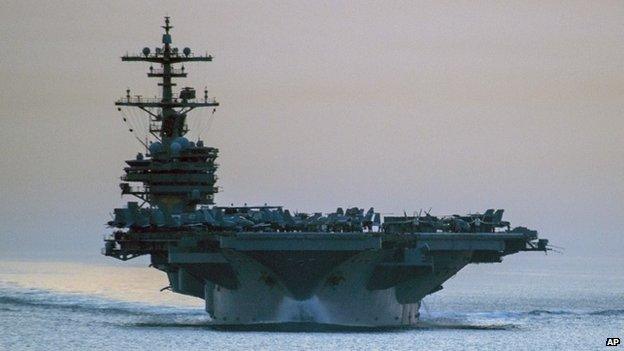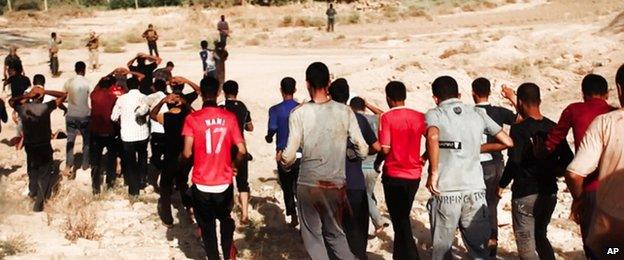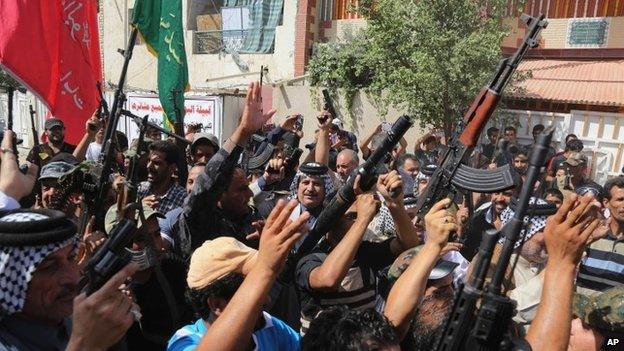Iraq conflict: Images purport to show 'massacre' by militants
- Published
The images appear to show captured Iraqi soldiers in civilian clothes being led away by militants, as John Simpson reports
The Sunni extremist group that has taken territory across Iraq has posted photos online that appear to show its fighters massacring Iraqi soldiers.
The army personnel are pictured being led away and then lying in trenches before and after their "execution".
Iraqi military spokesman Lt Gen Qassim al-Moussawi said the pictures were authentic and depicted events in Salahuddin province.
But the images' authenticity has not been independently confirmed.
The BBC's Jim Muir, in northern Iraq, says if the photographs are genuine, it would be by far the biggest single atrocity since the time of the American-led invasion of Iraq in 2003.
Their emergence came as the Iraqi government claimed to have "regained the initiative" against the offensive by Sunni rebels led by ISIS - the Islamic State in Iraq and the Levant.
Extremists captured key cities, including Mosul and Tikrit, last week, but several towns have now been retaken from the rebels.

The USS George HW Bush has been sent to the Gulf by the US along with two other military vessels
Washington remains concerned at the security situation in Iraq and has announced it is increasing security at its embassy in Baghdad and relocating some staff to safer areas.
The embassy would remain "fully equipped to carry out its national security mission", the US state department said.
The USS George HW Bush aircraft carrier is being deployed to the Gulf, accompanied by two more warships. But the Washington says no US troops will be deployed on the ground in Iraq.
Neighbouring Iran has offered direct assistance to Baghdad, but denies sending troops. However, there are reports of more than 130 Revolutionary Guards on hand to provide training and advice.
US newspaper The Wall Street Journal (WSJ) reported Sunday that the US is preparing to open talks with Iran over the situation in Iraq.

The pictures have not been independently verified, but military sources said they were authentic
'Taken to their deaths'
The massacre pictures, apparently posted by ISIS, are said to show what happened to soldiers after the group took over an army base in Tikrit.
Video footage, apparently filmed earlier, shows many hundreds of men being marched off, with the voice on tape saying they had surrendered at the Speicher base.
Still photographs show large numbers of young men being transported away in trucks.
Captions on the photographs, which again appeared to have been issued by ISIS, said they were being taken away to their deaths.
What appear to be ISIS fighters are seen firing on their captives in some images.

Analysis: Jim Muir, northern Iraq
If the images purportedly put out by ISIS itself are genuine - and there is little to indicate they are not - the methodical massacre of hundreds of Shia soldiers from the Iraqi army that they document is likely to inflame sectarian passions yet further.
That indeed may be one of the main objectives of ISIS in disseminating the gruesome pictures. Its narrative is consistently sectarian and provocative, as was that of its precursor, al-Qaeda in Iraq, when sectarian bloodletting between Sunnis and Shia was at its height in 2005-6.
The detonation of bombs and suicide attacks in mainly Shia neighbourhoods and against Shia pilgrims, for which ISIS has taken responsibility, all tend in that direction. So too did a statement last week by the ISIS spokesman urging the Sunni militants to march on the southern city of Kerbala, revered by the Shia.
ISIS has never shrunk from publishing images of its fighters committing what much of the world would consider atrocities and war crimes. It has no inclination to court international opinion, and it may be a useful way of striking fear into the hearts of its enemies.

The insurgency is increasingly splitting communities along sectarian lines, as Paul Wood reports
Sources in the rebel movement, who do not belong to ISIS, told the BBC they believed as many as 1,000 personnel from the base had been executed.
They said the ISIS fighters had divided them into regular army conscripts, who were set free, and volunteers from Shia militias or from the government's elite Golden Brigade, who were condemned to die.
Fightback
Earlier, Iraqi army spokesman Lt Gen Qasim Ata said the military had scored successes against the militants in several areas, killing 279 of them. The figure could not be independently verified.
There were reports of heavy clashes round the city of Tal Afar, west of Mosul, with mortar shelling of some districts as militants tried to enter the city.
Government forces were reported to be building up in the city of Samarra, north of Baghdad, ready for a counter-offensive on Tikrit.
Kurdish and Shia groups have formed militias to combat the Sunni insurgents, as Paul Wood reports
In other developments:
Three Iraqi soldiers and three Shia militiamen were killed in a mortar attack on a military recruitment centre near the city of Baquba, north-east of Baghdad
In one town that changed hands, Ishaq, security forces said they had found the incinerated bodies of 12 policemen

There are reports that thousands of men have joined Shia militias

ISIS in Iraq
The Islamic State in Iraq and the Levant (ISIS) has 3,000 to 5,000 fighters, and grew out of an al-Qaeda-linked organisation in Iraq
Joined in its offensives by other Sunni militant groups, including Saddam-era officers and soldiers, and disaffected Sunni tribal fighters
ISIS has exploited the standoff between the Iraqi government and the minority Sunni Arab community, which complains that Shia Prime Minister Nouri Maliki is monopolising power
The organisation is led by Abu Bakr al-Baghdadi, an obscure figure regarded as a battlefield commander and tactician
